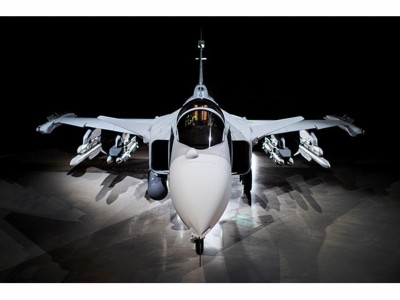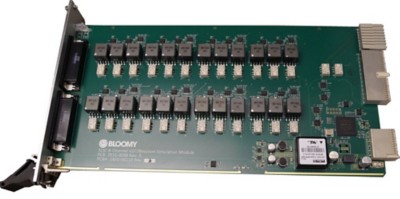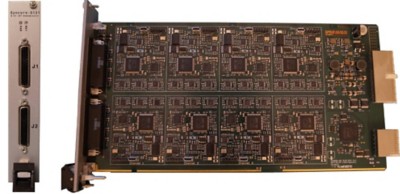Saab Elevates Testing of the World’s Most Cost-Effective Fighter Plane
Anders Tunströmer, SAAB Aeronautics

"Without the SLSC, we may have needed to spend thousands of man hours and many thousands of euros in materials to develop the system ourselves. . . .Having a COTS product means we can contain development and maintenance costs promoting the Saab initiative to break the cost curve. Using the SLSC system further promotes our goal to focus the attention on building HIL test systems and rigs, not developing advanced hardware."
- Anders Tunströmer, SAAB Aeronautics
The Challenge:
Saab needed to find a commercial off-the-shelf (COTS) solution to replace our custom system for interfacing to line-replaceable units (LRUs) in Saab Aeronautics simulators.
The Solution:
We reduced cost and ensured maximum flexibility by joining NI in piloting its Switch Load and Signal Conditioning (SLSC) system, rather than developing a custom system to interface to the preferred CompactRIO and PXI-based systems.

Introduction
Saab serves the global market with leading products, services, and solutions for industries from military defense to civil security. We pride ourselves on being the world’s most cost-effective, high-tech defense and security company. In the Aeronautics Division, located in Linköping, Sweden, the Gripen Fighter System is a key product. The Gripen is a unique fighter concept that balances excellent operational performance, sophisticated technology, industrial partnership, and cost efficiency in a single, smart multirole fighter system.
We are currently developing a new addition to the Gripen family, the Gripen E. This plane will feature the latest avionics technology, improved radar systems, and more advanced communication of important combat information between fighters.
The HIL Application
To help develop the fighters, we are building simulators and rigs for our hardware-in-the-loop (HIL) systems to test various Gripen line-replaceable units (LRUs). These LRUs include flight control systems, tactical systems, sensors, and other avionics equipment. In our most complex tests, up to 40 interconnected LRUs must be tested together. We began looking for a suitable commercial off-the-shelf (COTS) product to use as an I/O system in our HIL systems and selected the NI PXI and CompactRIO platforms because they are both modular and easy to expand. This is advantageous for our systems, which often have many different signal types. We built our HIL system based on several CompactRIO systems and use LabVIEW to control it. We can easily add more CompactRIO devices when required.
An HIL system lets us check that the LRUs work as expected by simulating the real-world environment it would run in. We can run many LRU tests without putting a fighter in the sky, which can be costly and potentially dangerous. In our HIL system, we use the CompactRIO to produce simulated signals for the LRU and receive the output from the unit.

Switching, Loads, and Signal Conditioning
To make the system specific to our application we needed custom signal conditioning and functionality between the CompactRIO and the LRU. We did not immediately find a COTS solution for customised signal conditioning along with switching and applying loads, so we started an internal development project to integrate the NI equipment with our simulators.
During this project we met with NI staff for an overview of the Switch Load and Signal Conditioning (SLSC) system. The SLSC solution extends PXI and CompactRIO measurement hardware with high-power relays for signal switching, power loads, and additional in-line signal conditioning capability. The system consists of a chassis with built-in active cooling capable of hosting 12 modules that can be used in applications such as our HIL testing.

The SLSC system looked interesting and similar to the one we were developing internally. It also made creating the system easier for us as NI is a preferred supplier for Saab already. By having NI define the ecosystem or “constraints” for switches, loads, and signal conditioning targeted at HIL applications with the NI platform, we could potentially lower costs as we would not need to spend time and effort defining them ourselves. We put our internal system development on hold to go with the COTS SLSC system.
We can choose from a variety of third-party SLSC modules, create our own, or contact third parties to build modules based on a detailed hardware and software development kit and design specifications from NI. This fits well with our custom needs, and we are following all of these paths. We create our own modules by working with a local developer called Syncore Technologies AB. As they are also based in Linköping, we can develop modules much faster, which is a huge advantage to us.
We can use the intellectual property from some of our existing designs quite easily using the SLSC MDK and design guidelines. We worked with NI to outline our requirements and partnered with aerospace domain experts and NI Alliance Partners, Bloomy Controls and SET GmbH, for modules.


Benefits of SLSC
We can use the SLSC system to focus on developing custom circuitry following the constraints defined by NI in the SLSC standard to save time and development resources. Without the SLSC, we may have needed to spend thousands of man hours and many thousands of euros in materials to develop the system ourselves. We would have had to consider the cooling, form factor, connectors, and more to create a custom signal conditioning system.
Having a COTS product means we can contain development and maintenance costs promoting the Saab initiative to break the cost curve. Using the SLSC system further promotes our goal to focus the attention on building HIL test systems and rigs, not developing advanced hardware.

Future Plans
We have already begun plans to integrate SLSC into one simulator at Saab. Although it is a large project, never done before, and with challenges, we are moving forward. With our savings from using a COTS system from NI, we plan to use CompactRIO and SLSC in a number of new simulators in the near future to continue testing innovative functionality for the Gripen fighters in a short timeframe and hitting the goal to lower the cost of test.
Recently, the Gripen E took off on its maiden flight over southern Sweden. It was a big success and another great milestone in our aviation history. We will begin to use our SLSC-based simulator to refine the Gripen E’s LRU systems further for delivery of the first aircraft in the next few years.
Author Information:
Anders Tunströmer
SAAB Aeronautics
Bröderna Ugglas Gata, Linköping, Sweden
Tel: +46 734 18 52 48
anders.tunstromer@saabgroup.com